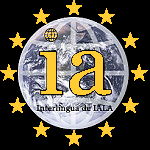Interlingua alphabet
| Interlingua | |
|---|---|

Logo
|
|
| Pronunciation | /ɪntərˈlɪŋɡwə/; IA: [inteɾˈliŋɡwa] |
| Created by | International Auxiliary Language Association |
| Date | 1951 |
| Setting and usage | Scientific registration of international vocabulary; international auxiliary language |
| Users | 1500 (2000) |
| Purpose |
International auxiliary language
|
| Latin script | |
| Sources | Source languages: English, French, Italian, Latin, Portuguese, and Spanish, with reference to some other control languages (mainly German and Russian). |
| Official status | |
| Regulated by | No regulating body |
| Language codes | |
| ISO 639-1 | ia |
| ISO 639-2 | ina |
| ISO 639-3 | |
| Glottolog | inte1239 |
Interlingua (/ɪntərˈlɪŋɡwə/; ISO 639 language codes ia, ina) is an international auxiliary language (IAL), developed between 1937 and 1951 by the International Auxiliary Language Association (IALA). It ranks among the top most widely used IALs (along with Esperanto and Ido), and is the most widely used naturalistic IAL: in other words, its vocabulary, grammar and other characteristics are derived from natural languages rather than a centrally planned grammar and vocabulary. Interlingua was developed to combine a simple, mostly regular grammar with a vocabulary common to the widest possible range of western European languages, making it unusually easy to learn, at least for those whose native languages were sources of Interlingua's vocabulary and grammar. Conversely, it is used as a rapid introduction to many natural languages.
Interlingua literature maintains that (written) Interlingua is comprehensible to the hundreds of millions of people who speak Romance languages, though it is actively spoken by only a few hundred.
The name Interlingua comes from the Latin words , meaning between, and , meaning tongue or language. These morphemes are identical in Interlingua. Thus, "Interlingua" would mean "language for intercommunication".
The expansive movements of science, technology, trade, diplomacy, and the arts, combined with the historical dominance of the Greek and Latin languages have resulted in a large common vocabulary among European languages. With Interlingua, an objective procedure is used to extract and standardize the most widespread word or words for a concept found in a set of control languages: English, French, Italian, Spanish and Portuguese, with German and Russian as secondary references. Words from any language are eligible for inclusion, so long as their internationality is shown by their presence in these control languages. Hence, Interlingua includes such diverse word forms as Japanese geisha and samurai, Arabic califa, Guugu Yimithirr gangurru (Interlingua: kanguru), and Finnish sauna.
...
Wikipedia
